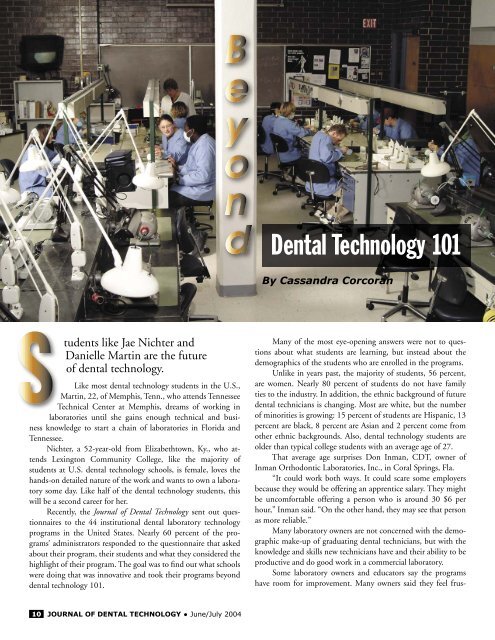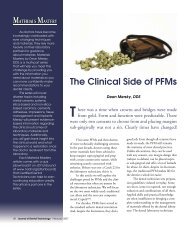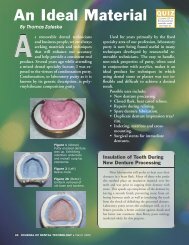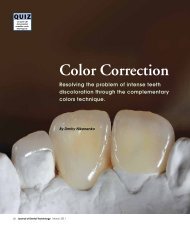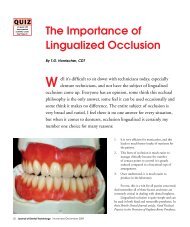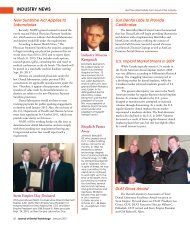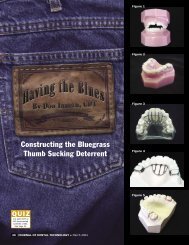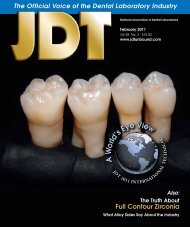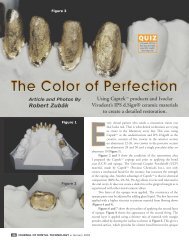Dental Technology 101 - JDT Unbound
Dental Technology 101 - JDT Unbound
Dental Technology 101 - JDT Unbound
- No tags were found...
Create successful ePaper yourself
Turn your PDF publications into a flip-book with our unique Google optimized e-Paper software.
<strong>Dental</strong> <strong>Technology</strong> <strong>101</strong>By Cassandra Corcorantudents like Jae Nichter andDanielle Martin are the futureof dental technology.Like most dental technology students in the U.S.,Martin, 22, of Memphis, Tenn., who attends TennesseeTechnical Center at Memphis, dreams of working inlaboratories until she gains enough technical and businessknowledge to start a chain of laboratories in Florida andTennessee.Nichter, a 52-year-old from Elizabethtown, Ky., who attendsLexington Community College, like the majority ofstudents at U.S. dental technology schools, is female, loves thehands-on detailed nature of the work and wants to own a laboratorysome day. Like half of the dental technology students, thiswill be a second career for her.Recently, the Journal of <strong>Dental</strong> <strong>Technology</strong> sent out questionnairesto the 44 institutional dental laboratory technologyprograms in the United States. Nearly 60 percent of the programs’administrators responded to the questionnaire that askedabout their program, their students and what they considered thehighlight of their program. The goal was to find out what schoolswere doing that was innovative and took their programs beyonddental technology <strong>101</strong>.Many of the most eye-opening answers were not to questionsabout what students are learning, but instead about thedemographics of the students who are enrolled in the programs.Unlike in years past, the majority of students, 56 percent,are women. Nearly 80 percent of students do not have familyties to the industry. In addition, the ethnic background of futuredental technicians is changing. Most are white, but the numberof minorities is growing: 15 percent of students are Hispanic, 13percent are black, 8 percent are Asian and 2 percent come fromother ethnic backgrounds. Also, dental technology students areolder than typical college students with an average age of 27.That average age surprises Don Inman, CDT, owner ofInman Orthodontic Laboratories, Inc., in Coral Springs, Fla.“It could work both ways. It could scare some employersbecause they would be offering an apprentice salary. They mightbe uncomfortable offering a person who is around 30 $6 perhour,” Inman said. “On the other hand, they may see that personas more reliable.”Many laboratory owners are not concerned with the demographicmake-up of graduating dental technicians, but with theknowledge and skills new technicians have and their ability to beproductive and do good work in a commercial laboratory.Some laboratory owners and educators say the programshave room for improvement. Many owners said they feel frus-10JOURNAL OF DENTAL TECHNOLOGY ● June/July 2004
trated by the amount of on-the-job training they have to provideto graduates. Suggestions for improving school programsinclude: increasing the length of programs to four years to allowfor more in-depth training; adding business training; spendingat least one year working on one specialty; and creatingmeaningful apprenticeship programs that would be requiredfor graduation.Owners aren’t alone, some educators think the systemneeds an overhaul.“The direction that dental laboratory technology schoolshave been taking is failing,” David W. Perkins, CDT, writesin his editorial Into the Future featured on <strong>JDT</strong> Online(www.nadl.org/jdt). “More and more schools are closing.And laboratories are much less satisfied with the graduates.Something has to change.”Perkins wants other schools to follow the lead of theAmerican Institute of Medical-<strong>Dental</strong> <strong>Technology</strong> in Provo,Utah, where he is the director of the dental technology program.He argues in his editorial that schools should determinetheir own curriculum, not the American <strong>Dental</strong> Association,that students’ hands-on time should be increased and thatthe fundamentals need to be stressed by using standardizedmethods.<strong>Dental</strong> technology educators say they are producing qualifieddental technicians and meeting the needs of laboratoryowners. Job placement figures of nearly 90 percent show theyare doing their jobs, educators said.Most ADA-accredited schools provide students with anentry-level knowledge base and skills in the five specialty areas,material science, tooth anatomy and occlusion, along withgeneral studies including communications and business principles,said Don Symington, CDT, head of the Indian RiverCommunity College dental technology program and the educatorrepresentative on the NBC Board of Trustees. Near theend of their studies, students concentrate in one specialty areato build their skill level.“My experience with negative feedback is from laboratoryowners who did not participate in formal education. A commoncomment is ‘After two years the kid takes a half hour towax a coping.’ This tells me the laboratory owner does not understandthat waxing a coping, or doing any other procedure, isa small part of the two years spent in school and this lab owneris not interested in the graduate’s knowledge in other areas.They are looking for a production worker and in that case, agraduate of a formal education program may not be a goodmatch,” Symington said.Donna Hood Karney, CDT, the NADL educator representativeand head of the dental technology program atTennessee Technical Center at Memphis, agreed.“The biggest problem we have is when people expect(graduates) to be department heads when they come out.They’re not trained that way,” Karney said. “They have a solidcontinued next pageAverage cost of in-state tuition forentire program: $5,793Lowest: Simi Valley Adult School andCareer Institute, $1,350Highest: Indiana University-PurdueUniversity Ft. Wayne, $20,500Average length of program:22 monthsShortest: California Vocational College,six monthsLongest: Tie- Kirkwood CommunityCollege and University ofTexas Health Science atSan Antonio, 30 monthsAverage number of studentsenrolled: 30Lowest: Putnam Career andTechnical Center, 7Highest: New York CityCollege of <strong>Technology</strong>, 150Source: School responses toa Journal of <strong>Dental</strong><strong>Technology</strong> questionnaireSchoolProgramStatisticsOpposite: Kirkwood Community College students must complete aclinical experience to earn an Associate of Applied Science degreeat this program based in Cedar Rapids, Iowa. (Photo: KirkwoodCommunity College)Below: Durham (N.C.) Technical Community College dentaltechnology instructor Ricky Glasgow, CDT, and Watkins Barker, one ofthe roughly 30 students enrolled in the program during an average fallor spring semester. (Photo: Durham Technical Community College)June/July 2004 ● JOURNAL OF DENTAL TECHNOLOGY 11
Beyond <strong>Dental</strong> <strong>Technology</strong> <strong>101</strong>, continued from page 11<strong>JDT</strong> asked psychologist and managementconsultant Curt Bonafigliawith Management Psychology Servicesbased in Atlanta, Ga., what affect anincrease in female dental techniciansgraduating from school would have onthe industry.“The increase in the numberof women entering dental technologymay reflect the industry trend toward customer service.Women traditionally thrive in service-oriented industries andas owners/managers; women will be well positioned to capitalizeon this advantage.“From a management perspective, most men managethrough a command and control style versus women’steam-building or consensus approach. Today’s CEO needs tobe more of a team-builder, a communicator who gives themanagement team and all employees a clear set of responsibilitiesand a firm vision. Openness, good listening skillsand willingness to change old ways of doing things are alsoimportant. The fastest growing and highest performing companieshave leaders that possess these attributes. And manyof these attributes match many of the top leadership traits ofwomen.“For dental lab owners, being able to keep technicians,managers and customers enthusiastic as they steer the companyforward may be the most important factor in success.Managers need to delegate outcomes, not tasks.“Women can do that better than men because their selfesteemis multifaceted.“Men’s self-esteem is typically unidimensional – basedon what they do.“Traditionally, women tend to have more of a desire tobuild than a desire to win. Women are more willing to explorecompromise and to solicit other people’s opinions. Many menthink that if they ask people for advice (or stop to ask for directions),they’ll be perceived as weak, unsure or as a leaderwho doesn’t have the answers.”During anaveragesemester, 20students attendthe dentaltechnologyprogram atColumbus (Ohio)State CommunityCollege. (Photo:Columbus StateCommunityCollege)foundation of knowledge. They’re not going to be a departmenthead. They’re going to be future department heads. Peopleexpect too much from a person who has been to school.”Many schools are emphasizing the importance of hands-onexperience and innovative teaching partnerships to upgrade dentaltechnology above the status quo.For example, at Kirkwood Community College in CedarRapids, Iowa, students participate in a laboratory exercise that introducesthem to implant components. The students fabricate asingle cemented anterior and a screw-retained, three-unit bridge,said program administrator Betty Mitchell, CDT. Also, dentaltechnology students are paired with dental students so they canobserve the preparation through final seating of various prosthodontictreatments. Similar partnering occurs at other schools,such as the University of Texas Health Science at San Antonio.Internships are a vital part of many students’ education. AtPasadena (Calif.) City College, for example, students are requiredto spend at least 10 hours each week in a laboratory for 16 weeks.At Idaho State University College of <strong>Technology</strong> in Pocatello,Idaho, students must complete 3-4 hours of hands-on work eachweek and complete an eight-week internship at the end of theprogram.Some schools have found ways to integrate technologiesinto their programs, many times with the aid of laboratoryowners.“Texas State Technical College at Harlingen has a verystrong relationship with the laboratory industry and can demonstratethis through equipment donations, scholarship moneyand industry involvement through special instruction and demonstrations(workshops) for students. All of these donations haveresulted in over $49,000 for the program last year alone. Withoutstrong industry support from lab owners in Texas, the programcould not survive in the competitive arena of technical education,”said department chair Randy Bauer, CDT.Many schools are being creative when it comes to recruitingstudents, as well. The University of Texas Health Science atSan Antonio has attracted future dentists, like Jihoon Rha, 26,of Dallas, Texas, who enrolled in the program while awaiting acceptanceinto dental school.“During my time off, I thought it would be a good way tospend my time. It will help me because I’ll know more aspects ofdentistry especially with dental schools not really teaching laboratorytechnology any more,” said Rha, who hopes to have anin-house laboratory at her own dental practice some day.A dental technician’s wealth of knowledge comes frommore than just institutional dental technology programs. Thereare some skills that only become ingrained once a technician ison the job, making appliances on a daily basis with the aid of inhousetraining. Also, knowledge comes from other educationalprograms, such as the Pankey Institute, the Las Vegas Institute,the Dawson Center for Advanced <strong>Dental</strong> Study, ProductivityTraining Corp., and supplier-sponsored clinics.12JOURNAL OF DENTAL TECHNOLOGY ● June/July 2004


